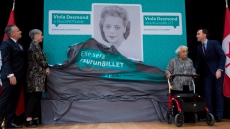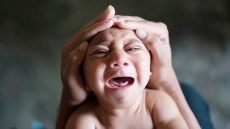OTTAWA — The Liberal government is seeking a record number of new immigrants this year by increasing spaces available for family reunification and refugee resettlement.
Between 280,000 and 305,000 new permanent residents will be admitted, a range that's the highest projected level in decades.
Immigration Minister John McCallum said the plan is grounded in Canada's tradition of being a welcoming and generous country.
"It outlines a significant shift in immigration policy towards reuniting more families, building our economy and upholding Canada's humanitarian traditions to resettle refugees and offer protection to those in need," he said at a news conference in Brampton, Ont.
Fewer spaces will be available to immigrants seeking to come for work, though McCallum said the high target mark of 162,400 people in economic programs is in line with admissions in recent years, even if the target itself is lower.

The refugee program will see the biggest boost.
In addition to the 25,000 Syrians the government has committed to resettling, it is prepared to triple the number of privately sponsored refugees this year, setting aside up to 18,000 spaces for them. In previous years, the number hovered around 6,000.
The Liberals are also opening up thousands of new spots in the family class programs, mostly for spouses and children.
While they are increasing the number of applications they'll accept for the popular parent and grandparent visa, they aren't raising the number of admissions in that program, as they continue to whittle away at a massive backlog.
But McCallum says more resources will be devoted to getting wait times down for many immigration programs, saying the government will draw a lesson from how fast it managed to get through the Syrian refugee applications.

Each November, the government is required to table a document in the House of Commons laying out how many new permanent residents it intends to accept in the coming year. The plan for 2016 was delayed by the October federal election.
A LOOK AT THE LIBERAL GOVERNMENT'S IMMIGRATION PLAN, BY THE NUMBERS
OTTAWA — The Liberal government released its plan Tuesday for how many new permanent residents they will seek to welcome to Canada in 2016.
The program is divided into three general streams — economic, family and humanitarian — and the Liberals say their plan represents a shift toward the latter two categories.
Overall, they're looking to increase the maximum by about 20,000 more people than the previous Conservative government had aimed for last year.
Here is a look at the Liberal plan and how it stacks up against previous ones, by the numbers:
2016

Planned total: 285,000 to 305,000.
Planned economic: 151,200 to 162,400.
Planned family class: 75,000 to 82,000.
Planned refugees, protected persons, humanitarian and other: 51,000 to 57,000.
2015

Planned total admissions: 260,000 to 285,000.
Planned economic: 172,100 to 186,700.
Planned family class: 63,000 to 68,000.
Planned refugees, protected persons, humanitarian and other: 24,900 to 30,200.
* actual admissions for 2015 are not yet available.
2014

Planned total: 240,000 to 265,000.
Actual admissions: 260,404.
Planned economic class: 151,400 to 167,200.
Actual admissions: 165,089.
Planned family class: 63,000 to 68,000.
Actual admissions: 66,661
Planned refugees, protected persons, humanitarian and other: 25,600 to 29,700.
Actual admissions: 28,622.
2013:

Planned total: 240,000 to 265,000.
Actual: 258,953.
Planned economic: 152,100 to 162,300.
Actual: 148,181.
Planned family: 63,800 to 73,500.
Actual: 81,831.
Planned refugees, protected persons, humanitarian and other: 24,000 to 29,000.
Actual: 28,941.


